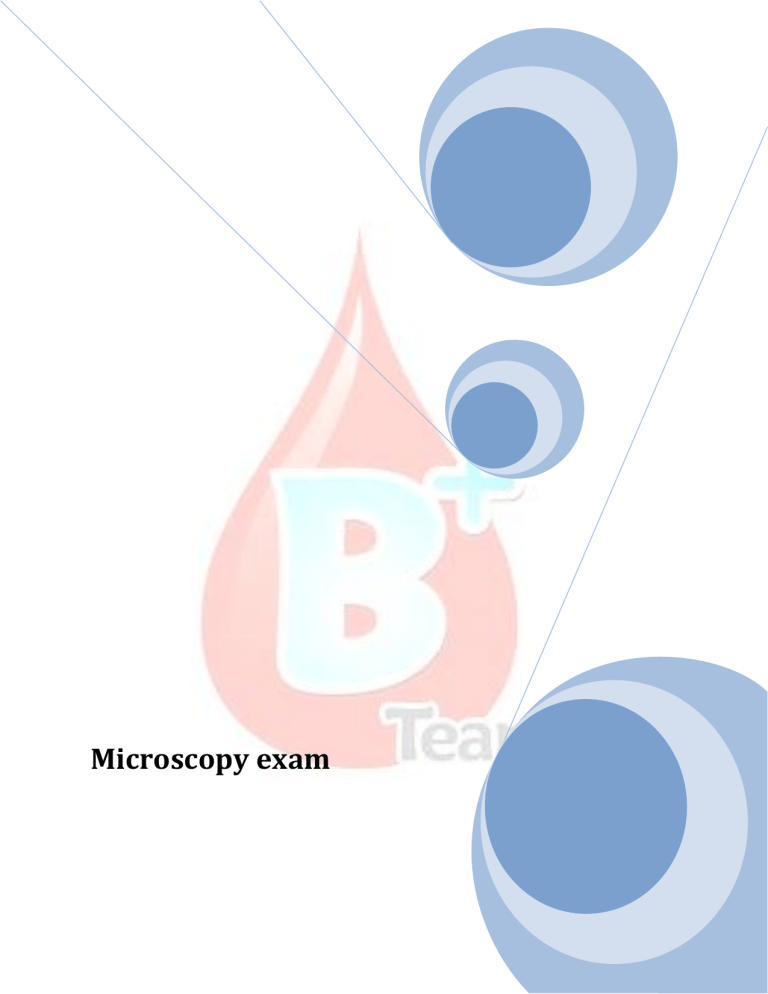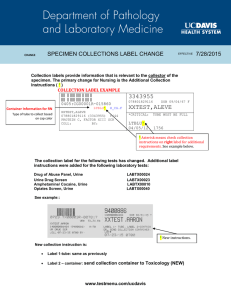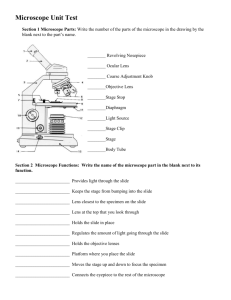
Microscopy exam 1. The urine specimen for cytological studies is: random specimen. 2. Which specimen eliminates contamination of urine: midstream clean catch? 3. Substances that show diurnal variation in their urinary excretion are the best: timed collection. 4. A woman complains of painful urination and suspected urinary tract infection the best specimen is: midstream clean catch. 5. A diabetic woman has renal insufficient the best specimen is: 2-hours postprandial. 6. The substance change with long time is: glucose and ketones are decreases. 7. Why do bilirubin, glucose, ketones and urobilinogen decrease with time: because the presence of bacteria. 8. PH increase and protein don’t change. 9. The most common form of urine preservation method: refrigeration. 10.in refrigeration of urine that occur: amorphous crystal may precipitate 11.Urine PH not changes with: water. 12.The two indicator use in urine pH determination: methyl red and bromothymol blue. 13.In bright microscope which lens produces the primary image magnification: Objective lens. 14.Microscope has 10 x magnification eyepieces&100 x objectives what's the total magnification: 1000X. 15.select the numerical aperture "N.A" that has ability to distinguish the smallest distance between 2 distinct points "the greatest resolving power: 1.25 16.The N.A of lens can be increased by: Increasing the refractive index of optical medium. 17.Which parameter will increase with increase in N.A of objective lens: Magnification & resolution? 18.Produces primary image magnification=objective lens. 19.Produces secondary image magnification: eyepiece. 20.Moves the specimen for viewing: stage. 21.optimally focuses light on to the specimen: condenser 22.Control the angle of light presented to specimen: aperture diaphragm. 23.control the diameter of light rays that strike the specimen: field diaphragm 24.Which of the following should be adjusted to decrease the illumination light or field brightness: Light source? 25.Which lens characteristic is described as ability to keep specimen image in focus regardless which objective lenses is used: Parfocal. 26.To achieve maximal image magnification & resolution: the condenser numerical aperture must be equal or greater than the objective numerical aperture. 27.Microscope lenses may be cleaned or polished using: lens paper. 28.when viewing focused specimen in the microscope the user sees a speck in the field of view it remain in view when the objective is changed and when specimen is moved the speck is most likely located on the: eyepiece. 29.Which type of microscope convert differences in R.I in to variation in light intensity to obtain the specimen image: phase contrast microscope? 30.A birefringent substance is one that: refracts light in 2 different directions. 31.Which type of microscope is able to produce 3D image and perform optical sectioning: interference contrast microscope. 32.The principle of fluorescence microscope: the absorption of light and its subsequent emission at a longer wavelength. 33.Which type of microscope use special condenser to direct light on to the specimen from oblique angle only: dark field microscope? 34.Is the preferred technique for identification of spirochetes: dark field? 35.Is often used for visualization of Ag-Ab and viruses: fluorescence. 36.Enable 3D viewing of unstained, low retractile specimen: interference contrast. 37.Is used to identify negative and positive birefringence: polarizing. 38.produce less haloing with thin flat specimen: phase contrast microscope 39.Bilirubin: yellow, orange. 40.Biliverdin: green. 41.Hemoglobin: red, brown. 42.Myoglobin: brown, red. 43.Urobilin: orange, brown. 44.Urobilinogen: colorless. 45.Urochrome: yellow 46.Urine that produces a large amount of white foam when mixed should be suspected to contain increased amount of: protein. 47.Which of the following substances will change the color of both urine and foam: bilirubin. 48.the clarity of well mixed urine specimen that has visible particulate matter and through which newsprint can be seen but not read should be described as: cloudy. 49.Small ion and large molecule have the same effect when determining urine concentration by the: osmolality method. 50.presence of these substance is pathogenic (P) or not (N): A. Bacteria (fresh urine): P. B. Bacteria (old urine): N. C. RBC: P. D. Renal epithelial cell: P. E. Spermatozoa: N. F. Sequamos epithelial cell: N. G. Urate: N. H. WBC: P. I. Yeast: P. 51.urine odor with substance or condition: A. Diabetes mellitus: sweet. B. Normal: faintly aromatic. C. Old, improperly stored urine: ammonia like. D. Specimen adulteration: ammonia, bleach. E. Starvation: a wet fruity. F. Urinary tract infection: ammonia pungent fetid. 52.How to evaluate urine color, clarity and consistency: mix well, use same depth or volume of specimens and evaluate the specimens at the same temp. 53.What criteria dose normal urine specimen has: clear yellow urine. 54.White participates in normal alkaline urine is most likely caused by: amorphous phosphate. 55.How you detect the presence of urinary protein and glucose: by the reagent strip method. 56.Which of the following specific gravity values is physiological impossible: 1.000. 57.Which of the following methods is an indirect measure of specific gravity: refractometer. 58.The refractive index of a solution is affected by: wave length of light used, size and number of solute present, concentration of solution, and temperature of solution. 59.Refractometer is preferred for specific gravity measurement because: use small amount of sample, fast and easy to perform, automatically compensates for temp. 60.The principle of the reagent strip method for measuring S.G is based on: the pka of a polyelectrolyte decreasing in proportional to the ionic concentration of specimen. 61.Why the S.G measurement using reagent strip provides useful clinical information: because the kidneys ability to concentrate urine is reflected in the reabsorption and secretion of ionic solutes. 62.Which of the following will not influence the volume of urine produced: carbohydrate ingestion. 63.Dipping the reagent strip into the urine for too long: is source of error result when using reagent strip. 64.To preserve the integrity of strip: stored in a tightly capped container. 65.Patient with chronic renal disease can no longer urinate concentrated urine have a specific gravity: 1.010. 66.Seminal fluid analysis performed o evaluated: post vasectomy status. 67. A seminal fluid pH greater than 7.8 is associated with: infection of male reproductive tract. 68.Immature spermatozoa are difficult to distinguish from: leukocyte. 69.Acid phosphatase identified positive in: seminal fluid. 70.Wave length visible to naked eye: 400-700 nm. 71.The diluent of WBCs: 3% glacial acetic acid. 72.Normal WBC in CSF: 0-5. 73.The diluent of platelets: 1% ammonium oxalate. 74.when using a 10x eyepiece and a 10x objective of a bright field microscope, the total magnification will be: A. 10. B. 100. C. 1000. D. 10000. 75.urinary pH may range from as: A. Low as 2.5 to as high as 7.0. B. Low as 4.5 to as high as 8.0. C. Low as 6.5 to as high as 7.4. D. Low as 6 to as high as 7.0. 76.the oil emersion lens have: A. 10. B. 40. C. 100. 77.in the microscope when using objective lens 40X & eyepiece 15X thee magnification power of the microscope is: A. 100. B. 1200. C. 600.




